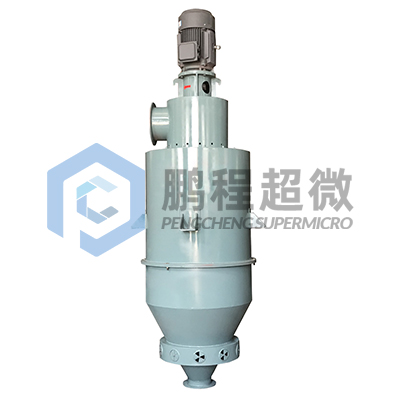Ultrafine powder classification technology
Whether you are removing coarse powder or separating fine powder, you can get satisfactory results.
The grading wheel can adjust the speed through the frequency converter to meet the requirements of product fineness and output.
Technical characteristics
Fineness d98 <2 µm to d98 <250 µm (based on calcium carbonate)
Vertical arrangement of grading wheels
In order to prevent coarse particles from being mixed into the product, there is a gas blocking device in the gap between the classification wheel and the fine powder outlet
The grading wheel shaft is sealed by compressed air to protect the bearings
Conical bottom with vertical coarse particle outlet
Bearings are sealed with grease, and lubricating oil for high-temperature air applications
The design optimizes the hierarchical structure and flow field design to obtain a particularly narrow particle size distribution
Only by adjusting the speed of the grading wheel, the highest level of fineness or maximum output can be obtained
The evenly distributed load of the grading wheel is realized through the rotationally symmetrical design of the equipment
The head of the grading turbine is divided into an elastic flexible coupling design, which is convenient for quick cleaning and maintenance
Good repeatability of product particle size test results
The machine is easy to operate and easy to clean.
Optional configuration provided: explosion-proof, vibration-proof and moisture-proof design, inert gas protection cycle process to ensure continuous safe and stable operation of flammable, explosive and oxidizing materials, airtight device, wear-resistant configuration
working principle
The fine powder moves at high speed from the inlet of the classifier along the updraft to the classification area under the suction force of the fan. Under the action of the strong centrifugal force generated by the high-speed rotating classification turbine, the powder mixed in the gas-solid two-phase fluid is divided according to the particle size The fine particles meet the particle size requirements and enter the cyclone separator or dust collector through the gap of the grading wheel blades. Some fine materials that do not meet the particle size requirements are entrained and fall along the cylinder wall under the action of centrifugal force and wall-impact stall. At the secondary air outlet, after the strong elutriation of the secondary air, the coarse and fine particles are separated, the fine particles rise to the classification zone for secondary classification, and the coarse particles fall to the discharge opening for discharge.
Application field
Non-metallic mineral powder (calcium carbonate, kaolin, quartz, mica, talc and other non-metallic mineral products), metal powder, synthetic chemical powder, food, new lithium battery materials, pigments, ceramics, refractory materials, medicine, pesticides, health products, new Materials, etc.;
Technical data
|
parameter |
VCF1 |
VCF2 |
VCF3 |
VCF4 |
VCF5 |
VCF6 |
VCF7 |
VCF8 |
|
Classification particle size d97:um |
3-45 |
4-150 |
5-150 |
6-150 |
8-150 |
10-150 |
12-150 |
15-150 |
|
Diameter of grading wheel |
100 |
300 | 360 | 450 |
550/600 |
800 |
1000 |
1200 |
|
Minimum processing capacity |
20 | 200 | 600 | 1000 | 1500 | 6000 | 13000 | 15000 |
|
Maximum processing capacity kg/h |
60 |
1000 |
2000 | 3000 | 6000 |
15000 |
20000 | 30000 |
|
Installed power KW |
7-11 |
7-11 |
11-42 |
18-60 |
63-105/77-140 |
120-160 |
150-200 |
170-320 |


